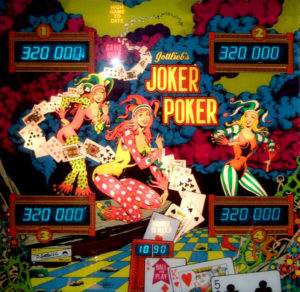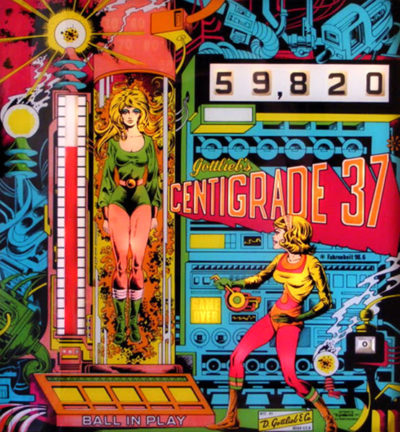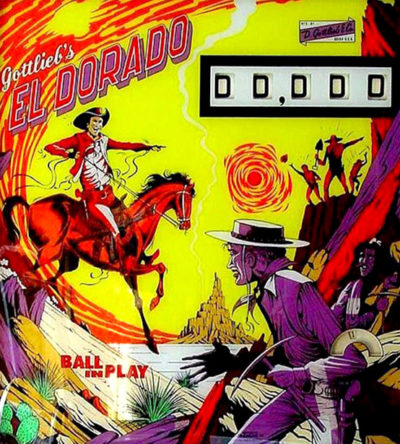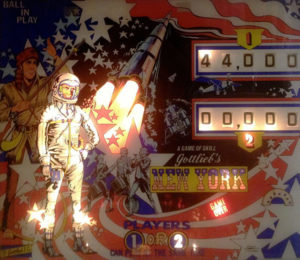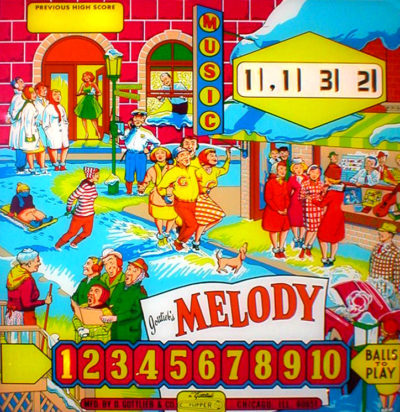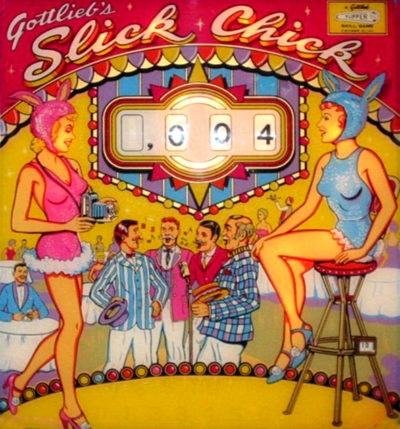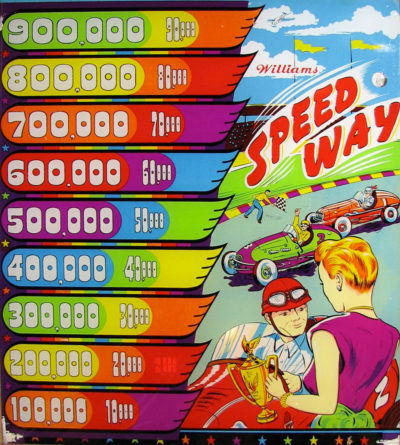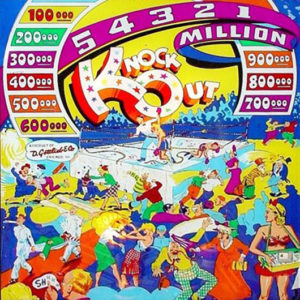-
Gottlieb Joker Poker pinball. An interesting design, and only made in a 4 player version (no 2 player, unusual for Gottlieb pinball). One bank of five ace drop targets, one bank of four king drop targets, one bank of three jack targets, one bank of two queen drop targets, and a single ten drop target. Pretty cool pinball design really. Two pop bumpers, one slingshot, two 3″ flippers. They made 820 Gottlieb EM Joker Poker pinballs.This game scores as the #10 most desirable game of the ’70s. It came out in August, designed by Ed Krynski and Allen Edwell with artwork by Gordon Morrison. Backbox animation is included in the game. A giant thermometer advances when drop targets are hit and by rolling over the rollovers. If the thermometer is advanced to the top, the special lights on the eject hole. A, B, C and D rollovers, if hit, advances the thermometer 5 advances. If a player completes all the letters, he gets 5,000 points in the eject hole. A double bonus feature is present also. All in all, a very fast-paced game. Artists, as a general rule, didn’t help design playfields. They were given the game mechanically more or less completed and had to invent the graphics and theme on their own.November marks the month of this game’s release. Design was one of Ed Krynski’s and art package was penned by Gordon Morison. This game had an add-a-ball version called Gold Strike as well as a re-released solid-state version. Gottlieb also duplicated this game design in Target Alpha (in the museum) and Canada Dry. 2,875 units were produced. If you like drop targets, this is your game. A battery of 10 drop targets are in the top of the playfield and a battery of 5 on the right mid-center. Four flippers are present for aiming at your foe. If you’re skillful enough to complete all the targets, a replay is awarded, 5,000 points are added, and a special lights up to score a replay if hit. If you drain your ball, the targets reset. An advancing light under the drop targets awards 5,000 points instead of the usual 500 points if you hit the drop target when it’s up and appropriately lit. Rollovers score 5,000 points when lit. Score awards replays also as well as matching.October was the birthdate for this machine. It was designed by Ed Krynski with artwork by Art Stenholm. Low production run of 550 units. This is an add-a-ball game, the replay version being called Sing Along. This game was a variation on a classic Gottlieb game Kings and Queens, in that it contains the four side-by-side kickout holes made popular in 1965. Here, the object of the game is to complete four same-colored numbers vertically in a row to randomly cause the kickout hole to light to score an extra ball if you land in the hole when it’s lit. If you didn’t win a ball, each light in the column would award 10 points. If you have most of the lights lit, a run at the kickout holes awards a lot of points in a hurry which, in this game, also awards extra balls. One center target is also incorporated into the game, awarding 100 points when hit and lights the pop bumpers for higher scoring.Gottlieb released the game “Sinbad” in both solid-state and electromechanical formats in June of the year. Designed by Ed Krynski with art by Gordon Morison, there were 12,000 S.S. games and 950 E.M. games made. This machine is the rare two-player version of the game, of which 730 were made. Drop targets are the main theme of this game. Knocking down the single white drop target awards a 2x bonus and lights the white rollover. The three yellow drops were next. If hit, 3x bonus is awarded when the ball drains and the 5,000 rollover lights at the top of the playfield. The four purple drops were next. Making these would award 4x bonus and light the extra ball rollover. Finally, the five red drops; when hit would award 5x bonus (the maximum bonus that could register is 15,000 points times the bonus) as well as light the special rollover. Four flippers allowed for interesting play, also.This April release was produced in a quantity of 4,550 units. Wayne Neyens designed the machine with Roy Parker doing the artwork. The art theme of the machine is Playboy bunnies as the Playboy Corporation opened a big Playboy club in the Chicago area in 1960 which was a real hit. The object of the game is to light the bumpers spelling out “Slick Chick.” It’s a tough game to master. Each time the sequence is completed, a rollover lights on the play field to score 10 points. If you can complete all five roll-overs, the center gobble hole lights to score a replay. Four roll-overs on the side of the play field numbered one to four also score a replay if hit in sequence. Score is your other goal toward replays. I remember playing this game at the arcades and it was very hard to achieve a winning combination. It is considered one of Wayne Neyens’ best games and one of his favorites in the annals of pinball design.Two banks of 5 drop targets, with two kickout holes above the drop targets. Three pop bumpers, no slingshots, and two 3″ flippers. The game play/rules behind Fastdraw is rather interesting, and a bit complicated for an EM pinball. First try and score the three A-B-C rollover targets. This increases the score value of the two kickout holes (1000 points plus another 1000 for each of the scored A-B-C rollovers, for a possible 4000 points max per kickout hole). Each of the three rollovers corresponds to a pop bumper too, so scoring the “A” rollover lights its pop bumper scoring 100 points instead of 10 points. Getting the three A-B-C rollovers also turns on the “extra bonus” light (double bonus for all but the last ball). Last ball gets double bonus by default, and if the A-B-C rollover lanes are scored, triple bonus is awarded. After the A-B-C rollovers are scored, knocking down all 5 of either the right or left drop target banks will also light the corresponding right or left kickout hole for Special. (The center pop bumper alternates the Special between the right and left kickout hole.) Also each drop target knocked down increases the end-of-ball bonus by 1000 points. Finally, knocking down all 10 drop targets makes the game raise the single center black drop target on each of the two drop banks. Now this single drop target is worth 5000 points. If one of the two center black drop targets is down, again that corresponding kickout hole will alternate lit as Special (assuming the A-B-C rollovers have been scored). If both black single drop targets are knocked down, the game resets these two black drop targets again. At the end of ball all targets and features reset, so it’s rinse and repeat for the next ball/player.Another rare machine stands before you. Although 2,885 units were produced, they were all sent to France as a promotion in a contest to market Canada Dry soda. Designed by Ed Krynski and art by Gordon Morrison, this game was released in the US as a one player, two player and four player version. If you like drop targets this is your game. Fifteen drop targets live in this playfield design! If you’re skillful enough to hit all the upper drop targets, the side extra ball rollovers activate. The same is true if you hit the bottom five drop targets. If, however, you’re skillful enough to complete all fifteen targets, the specials are activated. Score is another way to win. The machines put on location in France provided high-scoring winners with monetary prizes from Canada Dry. I wish they would do this in the united States, especially in Atlantic City.This game was produced in December of the year and designed by Harry Mabs with artwork by Roy Parker. 3,000 of these machines were made. The unique feature built into this machine is the animation unit in the top center of the play field. Two mechanical men are represented as boxers in a boxing match. Lights illuminate the bout when a knockout is scored by rolling over a “KO” rollover, a “KO” target, or completing bumpers 1 to 5. This game is one of the first examples of pinball animation. Another feature of the game is the pop-up bar at the bottom of the play field, preventing you from losing your ball in play for an extended period. Since the gap between the flippers is so massive, this addendum to the play field was installed to prolong the play period of the ball. A special feature is included in the game as well as a replay if 15 knockdowns are scored in one game and a replay for every knockdown scored thereafter.
-
Gottlieb Joker Poker pinball. An interesting design, and only made in a 4 player version (no 2 player, unusual for Gottlieb pinball). One bank of five ace drop targets, one bank of four king drop targets, one bank of three jack targets, one bank of two queen drop targets, and a single ten drop target. Pretty cool pinball design really. Two pop bumpers, one slingshot, two 3″ flippers. They made 820 Gottlieb EM Joker Poker pinballs.



